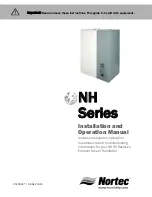
Installation
12
DryCool HD Operator and Maintenance Manual
P00960167-1
`ê~ïä=pé~ÅÉ=fåëí~ää~íáçå
: Install a separate return for the unit in a central area of the structure. Duct the
supply of the DRYCOOL™ HD to an 8" x 8" x 8" tee/damper that is 20% open to the crawl space. Duct the
other side of the tee to the air supply of the existing HVAC system. Connect 8" ducts to the reactivation inlet
and outlet to supply ambient air for reactivation and to expel moist air outside the crawl space.
3.5. Installation in an Attic with Existing Forced Air HVAC
Figure 5: Attic Installation
ALWAYS install a secondary catch pan with a drain or float interrupt for condensate under the DRYCOOL™
HD in an attic.
Locate a separate return for the unit in a central area of the structure or draw air from return ductwork. Duct the
supply side of the unit to the air supply of the existing HVAC system. Connect 8" ducts to the reactivation inlet
and outlet to supply ambient air for reactivation and to expel moist air outside the attic.
3.6. Installation for Dehumidification for a Stand Alone Space
One of the benefits of a DRYCOOL™ HD is the delivery of dehumidified air to the space at approximately the
same temperature that enters the device. This allows an owner to simplify the installation for applications or
instances where it is desired to maintain humidity levels in one open space. In these applications the return air
from the space is connected directly to the unit and the dehumidified air can be delivered directly back into the
room without the need to mix it with cold air coming from a central air conditioning system.
If the space is a large common room and is open to other adjacent rooms, using the DRYCOOL™ HD can have
the effect of providing dehumidification to much larger connected areas or even a small structure. This is
because water vapor diffuses from areas of high vapor pressure to areas of low vapor pressure. When large
spaces are dehumidified with a unit, areas of low vapor pressure are created and will induce water vapor
movement from other connected open rooms without the need for ducting.















































